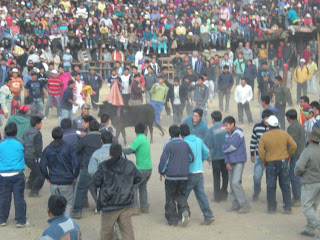Transportation can be full of surprises in Peru
To get to my regional capital, Huaraz, from
Huallanca I typically have a 3 ½-4 hour bus ride. During the rainy season its
not uncommon for the weather to impact travel on some of the roads that are in
worse condition but the road to Huallanca is in pretty good shape because it’s
a mining town and they have the money to make sure that transportation is as
good as it needs to be for them. We had one little mishap though when a bridge
went out about half way between Huaraz and Huallanca.
At first I thought there was a traffic accident when our bus
stopped behind a long line of traffic. But after asking around I found out that
there was a bridge out and no way for the bus to get through.
This is an exact profile of the gap that used to be a bridge
so it’s a bit difficult to make it out, but heck you get to see the mountains
at least.
It sounded like I might have to go
back to Huaraz and be stuck outside of my site for a while, but then the driver
told us that the bus coming from Huallanca was stuck on the other side of the
no-longer-existent bridge. Problem solved. Walk to the other side of the river
(crossing an old bridge that wasn’t washed out) and both buses would return in
the direction they came from. Unfortunately the police had stopped traffic a
couple miles away from the bridge so we’d have to walk all the way and pray
that the bus on the other side didn’t take off without us. But for some reason the police let a few cars
past that charged us a couple sols to drive us to the missing bridge.
Obviously they couldn’t drive us
across a bridge that wasn’t there, though, so after a 20 minute hike out to an
old bridge (through a muddy field) we made it across. And lo and behold, at the
end of the line of backed up traffic was my bus waiting to go back to
Huallanca.
My boots got really dirty, but you
can’t really see that here. But if the blog post was all words and no pictures,
it would also be no fun.
Bridges going out aren’t the only
problem you can run into in Peruvian transportation. Another day on a bus we
got a flat tire.
I’ve had a few flat tires in my life, so I figured it wasn’t
a big deal.























